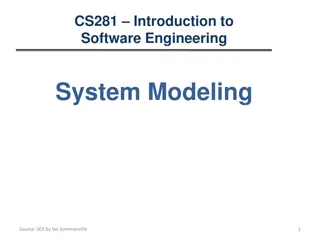System Models in Software Engineering: A Comprehensive Overview
System models play a crucial role in software engineering, aiding in understanding system functionality and communicating with customers. They include context models, behavioural models, data models, object models, and more, each offering unique perspectives on the system. Different types of system models such as data flow, composition, architectural, classification, and stimulus/response models help in representing and analyzing various aspects of a system. Context models illustrate system boundaries, behavioural models describe system behaviors, and architectural models depict system structures and relationships with other systems.
Download Presentation

Please find below an Image/Link to download the presentation.
The content on the website is provided AS IS for your information and personal use only. It may not be sold, licensed, or shared on other websites without obtaining consent from the author. Download presentation by click this link. If you encounter any issues during the download, it is possible that the publisher has removed the file from their server.
E N D
Presentation Transcript
SOFTWARE ENGINEERING UNIT III (Part - 1) SYSTEM MODELS Text Book: Software Engineering, A practitioner s approach Roger s. Pressman 6th Edition -McGraw-Hill
Topics covered Context models Behavioural models Data models Object models CASE workbenches
System models Abstract whose analysed. descriptions requirements of are systems being
System modelling System modelling helps the analyst to understand the functionality of the system and models are used to communicate with customers Different models present the system from different perspectives External perspective showing the system s context or environment Behavioural perspective showing the behaviour of the system Structural perspective showing the system or data architecture
Types of System Models Data flow model showing how the data is processed at different stages Composition model showing how entities are composed of other entities Architectural model showing principal subsystems that make up a system Classification model (Object diagrams) showing how entities have common characteristics Stimulus/response model showing the system s reaction to internal and external events
Context models Context models are used to illustrate the boundaries of a system Social and organisational concerns may affect the decision on where to position system boundaries Architectural models show that a system and its relationship with other systems
Behavioural models Behavioural models are used to describe the overall behaviour of a system Two types of behavioural models are Data processing models that show how data is processed as it moves through the system State machine models that show the systems response to events
Data-flow Models Data Flow Diagrams model the system from a functional perspective Tracking and documenting how the data associated with a process is helpful to develop an overall understanding of the system Data flow diagrams may also be used in showing the data exchange between a system and other systems in its environment
State machine models These model the behaviour of the system in response to external and internal events They show the system s responses to stimuli so are often used for modelling real-time systems State machine models show system states as nodes and events as arcs between these nodes. When an event occurs, the system moves from one state to another
Semantic data models Used to describe the logical structure of data processed by the system Entity-relation-attribute model sets out the entities in the system, the relationships between these entities and the entity attributes Widely used in database design. Can readily be implemented using relational databases
Data dictionaries Data dictionaries are lists of all of the names used in the system models. Descriptions of the entities, relationships and attributes are also included Advantages Support name management and avoid duplication Store of organisational knowledge linking analysis, design and implementation
Object Models Object models describe the system in terms of object classes An object class is an abstraction over a set of objects with common attributes and the services (operations) provided by each object Various object models may be produced Inheritance models Aggregation models Interaction models
Object models Natural ways of reflecting the real-world entities manipulated by the system More abstract entities are more difficult to model using this approach Object class identification is recognised as a difficult process requiring a deep understanding of the application domain Object classes reflecting domain entities are reusable across systems
Inheritance models Organise the domain object classes into a hierarchy Classes at the top of the hierarchy reflect the common features of all classes Object classes inherit their attributes and services from one or more super-classes. these may then be specialised as necessary Class hierarchy design is a difficult process if duplication in different branches is to be avoided
The Unified Modelling Language Devised by the developers of widely used object- oriented analysis and design methods Has become an effective standard for object-oriented modelling Notation Object classes are rectangles with the name at the top, attributes in the middle section and operations in the bottom section Relationships between object classes (known as associations) are shown as lines linking objects Inheritance is referred to as generalisation and is shown upwards rather than downwards in a hierarchy
Multiple Inheritance Rather than inheriting the attributes and services from a single parent class, a system which supports multiple inheritance allows object classes to inherit from several superclasses Can lead to semantic conflicts where attributes/ services with the same name in different super- classes have different semantics Makes class hierarchy reorganisation more complex
CASE workbenches (Computer Aided Software Engineering) A coherent set of tools that is designed to support related software process activities implementation or testing Analysis and design workbenches support system modelling during both requirements engineering and system design These workbenches may support a specific design method or may provide support for creating several different types of system model such as analysis, design,
Method support tools Diagram editors Model analysis and checking tools Repository and associated query language Data dictionary Report definition and generation tools Forms definition tools Import/export facilities Code generation tools
Elements Of Computer Science and Engineering Any questions?
Elements Of Computer Science and Engineering Scan The QR for More Info























